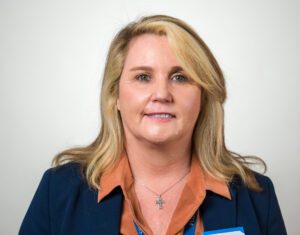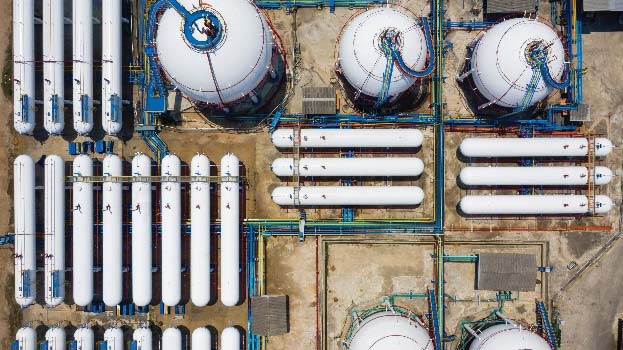Working on the FAST LNG project makes for a diverse and challenging experience. The project efficiently delivers processing units for offshore LNG and working your way through procurement challenges and limited material availability makes for an exciting task. Valve World spoke with Claire Dwyer, Lead Piping Material Engineer at Fluor, to learn more.
By Alexandra Kist, Valve World

Claire Dwyer’s career at Fluor started in Johannesburg, South Africa, when she started out as a Piping Designer in 1988, during which she was still attending college. Later, she transferred to Houston, Texas, to work in the Piping Material Engineering group, after which she took on the role of Operations Supervisor, managing the same group. She has been recognized as a subject matter expert (SME) for valves.
Claire became a Fluor Fellow in 2020, in recognition of her specialty for developing and specifying piping material and valves. She currently holds the position of Lead Piping Material Engineer and focuses on the FAST LNG (liquefied natural gas) project.
Her primary responsibilities include identifying correct valve usage, ensuring that piping systems meet the requirements of ASME (American Society of Mechanical Engineers) B31.3 and other applicable codes and standards, issuing requisitions, evaluating bids, and issuing purchase orders as part of the piping specification scope. She also assists younger engineers in their growth and development. Furthermore, she is Fluor’s representative at the API (American Petroleum Institute) Standard Refining Meetings and a member of the Valve World Dusseldorf, Valve World Americas, and Fugitive Emissions Americas Steering Committees.
FAST LNG
Through the FAST LNG project, Fluor develops a marine-based natural gas liquefaction (LNG) and export facility. ‘FAST’ is not an acronym; it merely stands for the focus on efficiently delivering concrete results. The project is an overarching name for a yet-to-be-determined number of LNG plants that are being constructed at a high pace. Fluor has worked on different kinds of constructions, which are installed on floating, transportable marine structures that are fixed (non-floating) when operating.

The current facility is three jack-up rigs, comprised of a liquefaction process unit, a gas treating process and utilities to enable full operation. The rigs are very close to each other, connected by hard pipe and flexible hoses. The latter had not been done before, which posed an interesting challenge to Claire and her team. “We often do a detailed front-end engineering (FEED), but because of the focus on efficiency, we jumped straight into detail engineering with a simple pre-feed package as a starting point,” Claire says.
Work on the first FAST LNG project started in March of 2021, and this was when the supply chain was still struggling to bounce back after the pandemic. Claire states that the procurement challenges made it especially hard to work at such a high tempo.
“For the second FAST LNG projects, we did a lot of modularisations, so we could take advantage of what we had done with that first project.We started the other FAST LNG projects with the same concept.” Modularisation is the practice of copying parts from earlier projects to speed up the process, as it saves a lot of time with regards to engineering design and procurement.Depending on the demand, the FAST LNG project could see any number of other smaller constructions in the future.
The goal for now is to go to market and to start producing. Claire and her team are currently mainly monitoring these smaller projects and making sure everything proceeds according to plan. Fluor is also working on the Cedar LNG project, the first indigenous-majority-owned LNG export facility in Canada. It will be a near-shore, permanently moored floating liquid natural gas (FLNG) facility.
The natural gas will be transported through an approximately eight-kilometre-long pipeline, which is connected to the Coastal GasLink pipeline. The natural gas will be liquefied at the project site and stored onboard the FLNG, after which it will be loaded onto an LNG carrier. “It is a near-shore, all electric drives, self-sufficient facility which utilises existing infrastructure and thus minimises impact on the local environment. Such an FLNG facility is quite a popular concept and, with some modification, can be deployed in different locations close to the gas and power sources.”
Responsibilities and materials
Claire’s responsibilities as a Lead Piping Materials Engineer means that she can work on multiple projects at the same time. She spends a part of her time on the Cedar LNG project and is always ready to help with anything that might pop up in the other projects, for which she readily offers suggestions and recommendations.
“The majority of my work revolves around manual valves. Control valves are handled by a different group. We’re also responsible for all the piping for manual valves: anything having to do with selection, standards, and codes. About half my work revolves around valve selection, procurement, and writing specifications for valves and other materials.”

Piping materials include pipe, fittings, gaskets, strainers, and flanges. One of the main issues to watch out for regarding materials is corrosion. To combat those effects, Claire explains that Fluor is often trying to source the higher alloys, but they’re always a challenge to find.
“I haven’t seen any improvement over the last couple of years. Instead, it seems the industry is trying to catch up with all the newer technology. Renewables seem to be a lot more corrosive. Another hot topic is the rise of carbon capture, for which Fluor has the technology but the industry economics have historically been challenging.
We’re starting to see these projects come to fruition due to recently passed legislation in certain regions. And now, hydrogen has just started to take off. Liquid hydrogen is the more critical of the lot because we do not have much experience with the lower temperatures. We haven’t seen much of it, but we know it’s there.

With regards to the limited availability of products and materials, Claire notes that projects will have to be aware that the delivery times will take longer. “The schedule has to allow for that,” she says. “It’s not something people involved want to hear, because they’d prefer everything to go quickly. The thing to do is to identify these challenges at the beginning of the project – different materials that are going to be more difficult to procure. Your goal is to order them as soon as you can.”
In addition to the struggle with materials, Claire also finds that there can be massive delays with valves, some of which are over a year late. It’s a challenge to use these experiences and learn from them; hopefully being able to minimise any delays for future projects, though not everything can be anticipated. “Generally, the more manufacturers you have, the better off you are. That, as well as the costs, are things you need to weigh up at the beginning. You try to make decisions based on the market and the number of suppliers available.”
Sustainability
The industry is moving towards greener energy, and one way Claire notices this is because Fluor is working on more projects in support of the energy transition toward a more sustainable future. “You can see that Fluor spends a lot of time going to different conferences, and presenting at lots of business forums. Right now, Fluor is very hopeful about the future and where we’re heading. It’s crucial to stay ahead of what’s to come and to have the expertise to deal with all those changes.”
About Cedar LNG
The Cedar LNG Project is a proposed floating liquefied natural gas (FLNG) facility in Kitimat, British Columbia, Canada, within the traditional territory of the Haisla Nation. The project is strategically positioned to leverage Canada’s abundant natural gas supply and BC’s growing liquefied natural gas (LNG) infrastructure to produce industry-leading low-carbon Canadian LNG for new overseas markets. By using an innovative design philosophy that fits the facility into the local environment, the Cedar LNG Project will minimize the impact to the local environment while creating value for customers and prosperity for both the Haisla Nation and the region.
Source: CedarLNG.com
About the company
Fluor Corporation is building a better world by applying their expertise to solve its clients’ greatest challenges. Fluor’s 40,000 employees provide professional and technical solutions that deliver safe, well-executed, capital-efficient projects to clients around the world. In 2022, Fluor was ranked 259 among the Fortune 500 companies. With headquarters in Irving, Texas, Fluor has provided engineering, procurement and construction services for more than 110 years.
About this Featured Story
This Featured Story is an article from our Valve World Magazine, June 2023 issue. To read other featured stories and many more articles, subscribe to our print magazine. Available in both print and digital formats. DIGITAL MAGAZINE SUBSCRIPTIONS ARE NOW FREE.
“Every week we share a new Featured Story with our Valve World community. Join us and let’s share your Featured Story on Valve World online and in print.”


